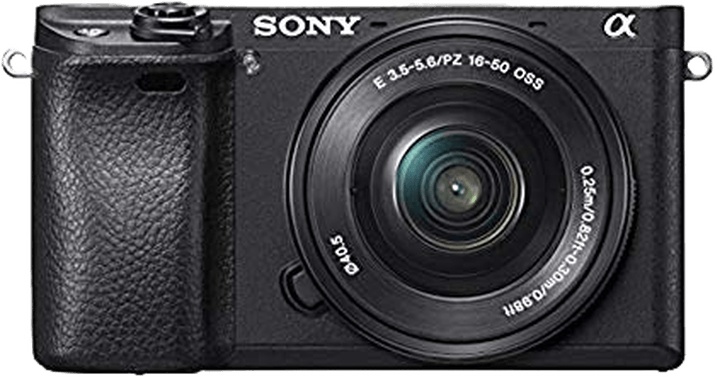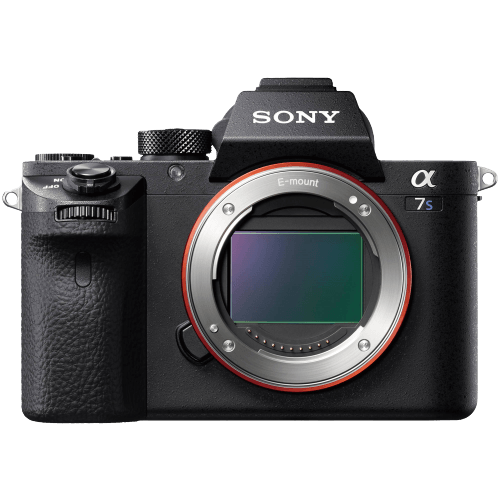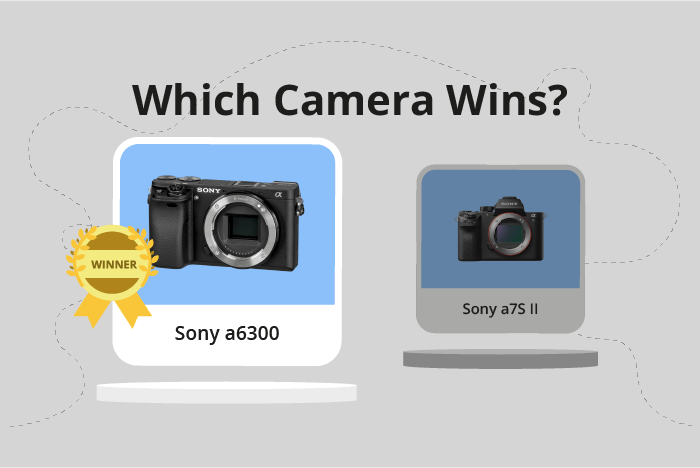Sony a6300 vs a7S II Comparison
Sony a6300

Sony a7S II

The Sony a6300 edges out the Sony a7S II with a score of 61/100 compared to 60/100. Both cameras are mirrorless and share similar features. However, the a6300 was released in 2016, a year later than the a7S II, and has a significantly lower launch price of $1000 compared to $3000. The a6300 is also smaller and lighter, measuring 120 x 67 x 49mm and weighing 404g, while the a7S II measures 127 x 96 x 60mm and weighs 627g.
The a6300’s higher score, lower price, and compact design make it a more attractive option for many users. On the other hand, the a7S II may still appeal to those who prefer a slightly larger and heavier camera. Ultimately, the choice between these two cameras comes down to personal preference and budget.
Sony a6300 vs a7S II Overview and Optics
The Sony a6300 wins in the optics category with a score of 68/100, while the Sony a7S II scores 66/100. Both cameras share common specifications like having a CMOS sensor, Bionz X processor, and the same DXOMARK score of 85 for the sensor.
The a6300 surpasses the a7S II with its higher megapixel count of 24.2, compared to the a7S II’s 12.2. This allows the a6300 to capture more detail in images. Additionally, the a6300 has a faster shooting speed of 11 frames per second, which is beneficial for action and sports photography. The a6300 also features an APS-C sensor size and is compatible with Sony E lens mounts.
On the other hand, the a7S II has its advantages, such as a full-frame sensor that provides better low-light performance and a shallower depth of field. The a7S II also features image stabilization, which the a6300 lacks, ensuring sharper images in various shooting conditions. The a7S II uses the Sony FE lens mount, which is compatible with a wide range of lenses.
In comparing the optics of these cameras, the Sony a6300 offers higher resolution and faster shooting speed, making it suitable for capturing detailed images and fast-moving subjects. The Sony a7S II, with its full-frame sensor and image stabilization, excels in low-light situations and provides greater flexibility with lenses. Each camera’s strengths cater to different photography needs, and the choice depends on the user’s preferences and requirements.
Sony a6300 vs a7S II Video Performance
The Sony a6300 emerges as the winner in the video department with a score of 91 out of 100, compared to the Sony a7S II’s score of 56. Both cameras possess the ability to capture 4K resolution videos with dimensions of 3840 x 2160, showcasing their high-quality video capabilities.
The similarities between the two cameras continue with their video features. However, the Sony a6300 outshines the a7S II in terms of video frame rate, offering a maximum of 120fps, which is significantly higher than the a7S II’s 30fps. This difference allows for smoother, more detailed slow-motion videos with the a6300. Additionally, the a6300 has a built-in time-lapse functionality, which is absent in the a7S II. This feature enables users to create time-lapse videos with ease, without requiring additional equipment or software.
Despite its lower score, the Sony a7S II still has its own strengths. Its full-frame sensor provides better low-light performance and a shallower depth of field compared to the a6300’s APS-C sensor. This advantage is particularly useful for filmmakers who need to shoot in challenging lighting conditions or desire a more cinematic look in their videos.
Taking these points into consideration, the Sony a6300 is the superior choice for video capabilities, with its higher frame rate and built-in time-lapse functionality. However, the Sony a7S II’s full-frame sensor and low-light performance should not be disregarded, as they can be valuable assets for certain filmmakers. Ultimately, the choice between these two cameras depends on the specific needs and preferences of the user.
Sony a6300 vs a7S II Features and Benefits
The Sony a7S II outperforms the Sony a6300 with a feature score of 57/100 compared to the a6300’s 54/100. Both cameras share several specifications, including a 3-inch screen, lack of touchscreen, flip screen, absence of GPS, WIFI connectivity, and no Bluetooth.
The a7S II has a notable advantage in screen resolution, boasting 1,228,800 dots compared to the a6300’s 921,600 dots. This higher resolution provides a clearer and more detailed image preview on the a7S II, enhancing the user experience.
Despite its lower overall feature score, the Sony a6300 does have certain strengths. It is a more budget-friendly option compared to the a7S II, making it a suitable choice for beginners or those on a tighter budget. However, this lower price point does not translate to a significant advantage in terms of features.
When examining the features of both cameras, it is evident that the Sony a7S II holds a slight edge over the a6300, particularly in terms of screen resolution. While the a6300 may be more affordable, the difference in feature scores is minimal, and the a7S II offers a superior viewing experience. Ultimately, the choice between the two cameras will depend on individual preferences and priorities, such as budget and desired image quality.
Sony a6300 vs a7S II Storage and Battery
The Sony a6300 triumphs over the Sony a7S II in storage and battery with a score of 24/100 compared to 21/100. Both cameras share common specifications, including one memory card slot, compatibility with SD/SDHC/SDXC memory cards, NP-FW50 battery type, and the absence of USB charging.
The a6300 outperforms the a7S II with a longer battery life of 400 shots, providing more time for photography before needing a battery change. This advantage makes the a6300 a more reliable choice for extended shooting sessions.
Conversely, the a7S II falls short with a battery life of 370 shots. However, it compensates by accepting Memory Stick Duo/Pro Duo/Pro-HG Duo cards, offering additional storage options to users.
Taking these factors into consideration, the Sony a6300 emerges as the better option for storage and battery, while the Sony a7S II provides more versatile storage options.
Sony a6300 vs a7S II – Our Verdict
Are you still undecided about which camera is right for you? Have a look at these popular comparisons that feature the Sony a6300 or the Sony a7S II:

